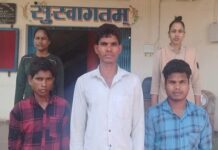Lotsawa Rinchen Zangpo is known as the father of culture in Ladakh
With the cold winds whistling through the Trans-Himalayan desert, and temperatures plummeting to minus fifty degrees, the painters, sculptors, skilled artisans and artists from Chamba, Kullu, Kinnaur and Kashmir worked with a religious zeal under the guidance of the great Lotsawa Rinchen Zangpo (958-1055A.D.), the chief priest and the Vajracharya of Tholing of the Guge Kingdom in Tibet.
They toiled day and night, adding a celestial dimension to the simple mud and stone monastic structures. They covered the walls with paintings depicting divine stories from the Buddha’s life, drew mystic mandalas and created heroic size stuccos of the Buddhist deities. And they built these magnificent monuments subjecting themselves to the harsh weather conditions, atop rocky cliffs and craggy faces of high mountains, where there were no roads and the building material was limited to mud and poplar wood. These ethereal mud edifices served as epicentres of the local art and culture of the religion and philosophy of the Vajrayana sect of Buddhism contributing greatly to the ancient and rich cultural relics of our country.
Ratna Badra, a young scholar, went to Vikramshila in Kashmir to study Sanskrit. On his return, he contributed immensely to the preservation of the Sanskrit Buddhist Sutras by translating them into Bhoti, the language of the Tibetans. Thus, he earned the title Lotsawa (translator) and came to be recognised as Lotsawa Rinchen Zangpo, who spread Buddhism in these parts and was the father of culture in Ladakh. He was a disciple of the famous Indian Master Atishaa.
Rare manuscripts
Rinchen Zangpo is believed to have constructed 108 gompas, most popular among them being the Tabo monastery known as the Ajantha of the Himalaya in Spiti, where rare manuscripts, thankas, frescos and murals are well preserved. The others include the Lalung; the Alchi, located in Khalsi on the banks of the river Indus, Lamayuru Monastery, the Wanla, the Mangyu and the Sumda. Legend goes that while undertaking the divine task of building these monasteries overnight, Rinchen Zangpo carried withered willow sticks with him to different sites in Ladakh, Zangskar, Spiti, Kinnaur, Bhutan and Arunachal Pradesh. Here, he planted them and wherever the sticks sprang to life and turned green, a monastery was constructed.
A thousand winters have flown by since this great master attained Buddhahood, but, the sacred texts, art and culture of the Mahayana Sect of Buddhism, are found even today only in these monasteries that are in India. The other noteworthy Buddhist temples built by him in Tibet faced destruction in the hands of the invading Red army in the 1950s.
In 1983, the Dalai Lama performed the Kala Chakra ceremony for world peace at the Tabo Monastery.
The monasteries of Tabo and Alchi are recognised by UNESCO as World Heritage Sites.















